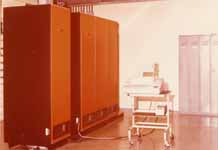This is an extension to telegraph methods used by computer terminals from the model 33 teletype to VDUs/VDTs (Video Display Units/Terminals). When serial data is transmitted, timing information must be sent to allow the information to be correctly decoded at the distant end.
Bit synchronisation information is required to allow the receiver to sample each bit at the correct time. Character synchronisation allows the receiver to divide the datastream into characters, ie to know where each character starts and stops.
In asynchronous operation both bit and character synchronisation are provided by the start and stop bits, when nothing is being transmitted a continious mark (logic 1) is being sent to line, when a character is sent the start bit causes a 1 -> 0 transition, 1.5 bit lengths after that will be the middle of the first bit, each bit is then sampled in turn until the stop bit which is always 1 to ensure a 1 -> 0 transition at the start of the next character.
Therefore no additional timing signals need to be provided by the modem but the terminal must know what speed is being transmitted to sample at the correct rate.
Users have to sort out, baud rates, parity, number of stop bits/ data bits and
any handshaking.
this is how a CR is sent to line
---+ +---+ +-------+ +--------------1=mark
| | | | | | | | | | |
+---+ +---+ +-----------+ 0=space
s 1 2 3 4 5 6 7 p s
t a t
a l m r o
r s s i p
t d d t
y
Stop/start is used when connecting to the Public Network pad.
line rate 110 b/s line rate > 110 b/s
number of stop bits PAD min 2 min 1
DTE-C min 1 min 1
coding of parity bit optional in all transmissions from the DTE-C, however in all user data transmitted or received by the DTE-C the coding of all 8 bits (7 character bits plus parity bit) will be passed transparently between the DTE-C and DTE-P. All characters generated by the PAD (eg PAD service signals) will be transmitted with even parity.
11 - Parity Slide
Practical PH2 - To connect two terminals across an asynchronous link
Procedure
1 - Connect up the equipment as follows -
+---+ +---------+ +-----------+ +---+
+--+ +---| send1+--|3rcv +---| +---+
+------+ |dte 2+--|4 dte| +-------+
terminal | rcv3+--|1send | terminal
| 4+--|2 |
+---------+ +-----------+
ASYNC ASYNC
MODEM MODEM
- Connect and switch on mains power to all equipment
- Try typing something on one terminal:
- is it sent to the other terminal?
- try typing carriage return?
- when is the message sent?
- TEE in a protocol tester to the V24 at either end of the link, set the protocol tester for ASYNC and HEX decoding.
- Type somthing on the terminal and check that it is being decoded correctly on the tester.
Objectives
- To show how to set up the protocol Monitors to see asynchronous data on the line.
- To show a asynchronous link.
- To show how to tee into the V24 link
Synchronous Serial Ports
see this page
Communicating with the Serial port using Java
see this page




